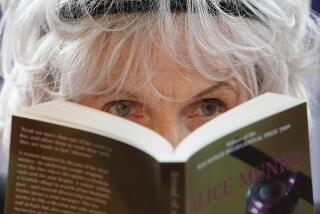Novelist Tom Wolfe Still Lighting Literary Fires
When Tom Wolfe speaks, you have to listen--hard. His Virginia voice is soft and calm. He delivers his most stinging remarks in polite tones suitable for discussing a distant relative’s hives or last Sunday’s overseasoned fried chicken.
Also--as usual--he is dressed to the nines. He is a fashion salad of checks, polka dots, stripes and solids, not to mention the two-tone shoes. In the flesh--fabric, that is--this can be distracting, even though Wolfe is almost as famous for his dandyism as for his enormous success as a writer.
So, pay attention. Keep your eyes in focus. Don’t look at those socks! And remember. . . .
For more than 20 years Wolfe has been a literary style-setter. In nonfiction he helped create the “new” journalism with his magazine pieces on car customizing, stock-car racing and high society. His books--including “The Right Stuff” and “The Electric Kool-Aid Acid Test”--sell like popcorn. Even dead writers don’t do as well with the critics.
Now Wolfe is weighing in--at age 56--with his first novel, a 600-plus-page behemoth called “The Bonfire of the Vanities,” a social satire that dices New York’s social layers into fine mincemeat. Naturally, it’s getting reviews that range largely between marvelous and almost marvelous. It’s a best seller.
This particular day Wolfe is in Beverly Hills, latest leg of a promotion tour that has brought him, unwrinkled and immaculate, from Texas.
Obviously pleased with the initial success of “Bonfire” and with his new vantage point as a fiction writer, he surveys the contemporary American novel--minimalist and postmodern--and proceeds to commit an extended verbal mugging with that mellow voice.
As Wolfe sees it, much of today’s American fiction is coming out of a literary wasteland where plots are shriveled and the characters suffer from terminal ennui.
This desert is producing today “what I call the anesthetic novel,” he says. “Nobody has any feelings. There’s a super-coolness. You’re always in the anteroom of death.
“Now there are two types, there’s the urban anesthetic novel and the rural. . . . I never could figure out why there were so many of the rural anesthetic novels because I know some of these writers and none of them have any rural roots. Then I discovered that so many of these writers make a living by teaching at large state universities. Housing being what it is, they go out into the countryside and rent a house and the house is usually broken down. After about the sixth time that they’ve talked to some plumber named Lud, they feel that they now understand the rural psyche.”
Wolfe is just getting wound up.
‘Fashionable Desperation’
The perfect character in an urban anesthetic novel is “insanely oblivious” to the environment, including terrorist bomb attacks across the street, he maintains. The characters “don’t care, they’re all stroked out.”
“It’s a sub-chapter of coolness, being cool at all costs, that kind of fashionable desperation,” Wolfe explains, drawing on his knowledge of his milieu to deliver the final cutting blow: “I know some of these people (the writers, not the characters). They’re not desperate. They worry about the usual things, whether or not the polished chintz sofa from Bloomingdale’s is right for their apartment.
” . . . The urban anesthetic novels are much written about today,” Wolfe continues, citing in particular Bret Easton Ellis’ slim, much-analyzed “Less Than Zero.”
“That’s the perfect title of an anesthetic novel, ‘Less Than Zero’. . . . A lot of these people are really very talented but they are writing sonnets. I don’t think we’d remember Shakespeare if he’d stuck to sonnets.”
The ultimate example of this sort of writing is a “marvelous” (that word again!) story by Robert Coover, Wolfe says.
It starts this way, he recites: “ ‘To begin with I went to live on an island and committed suicide.’ That’s the first sentence--and there are no flashbacks. It’s a virtuoso performance but now things have been stripped down so far that there’s really--to my take--nothing left.”
So, what’s Wolfe’s prescription for humanizing this bleak landscape?
That’s easy, go back to the 19th Century when novels were lusher--more like jungles than some unwatered part of Southern California. Emulate the great portrayers of society from the high to the low, Wolfe says. Guys like Charles Dickens, Balzac, the kind they used to teach in high school.
“Bonfire” is, among other things, an attempt to recapture the reportorial spirit of the last century’s novelists, Wolfe says, noting that his forays into the nooks and crannies of New York’s criminal justice system for his novel were “a joy.”
Paraphrasing fellow novelist Philip Roth, Wolfe adds that novelists should not limit themselves to their own “private worlds” because “we live in an age in which the imagination of the novelist is powerless before what he knows he’s going to read in tomorrow morning’s newspaper.”
A few minutes later, however, he sounds a bit wistful that even the most fertile imagination probably can never rival the scandal created by television preacher Jim Bakker, his wife Tammy and their supporting cast earlier this year.
“How could a novelist get away with a story in which a Southern TV evangelist is caught in a tryst with a church secretary from Babylon, N.Y. . . . and ruined and has to sell all his possessions, including his air-conditioned doghouse?” he asks with what appears to be amazement and envy.
Undaunted nonetheless, Wolfe says the reporter-novelist in him sent him all over New YorkCity in search of real people and real situations.
One of those encounters with life gave him a suitable profession for the novel’s main character, Sherman McCoy.
(In a first version of “Bonfire” serialized several years ago in Rolling Stone magazine, McCoy was a writer, which is a pretty boring job because so much time is spent “comatose in front of a typewriter,” Wolfe says.)
“I hate books where people have occupations and you never see them working,” he adds. “It’s like those old Cary Grant movies where he’s a doctor and he doesn’t even have a tongue depressor.”
So Wolfe decided to make McCoy a bond salesman after he saw the “frenzy of the trading floors of these investment banking houses . . . legions of young white men--there are almost no women--just baying for money. The first time I got off the elevator at one of these places I heard a roar, which is like the roar that you hear if you’re outside a football stadium in the closing minutes of some bloodthirsty game.”
‘I Said That’s Great’
He did his research well, the novelist says with satisfaction. “One of the reviews that I was proudest of was in a newspaper called Credit Markets, which is a trade magazine of the bond business. They found it authentic and interesting and I said that’s great.”
When it comes to reviews, Wolfe seems to be a tad defensive about critical barbs that he is obsessed with fashion and appearances. In “Bonfire,” Wolfe lovingly describes every major character’s wardrobe, physique, dwelling, diet and table-setting--and frequently includes the price tag..
“All my career, I’ve been criticized for my attention to clothes, (in) nonfiction as well as this,” he says. “I find it (fashion) irresistible. That’s the first thing everybody in this world notices whenever people meet.”
Toward the end of the interview he comes back to this subject. “I was much relieved in reading a biography of Balzac to see that he was criticized for his love of describing furniture. (Critics said,) ‘Why doesn’t this little man who’s so in love with furniture open a shop and stop pestering us with these furniture catalogues he passes off as novels?’ ”
The implication is obvious: Balzac’s “catalogues” are still available in nearly every bookstore and library.
Who remembers his critics?
More to Read
Sign up for our Book Club newsletter
Get the latest news, events and more from the Los Angeles Times Book Club, and help us get L.A. reading and talking.
You may occasionally receive promotional content from the Los Angeles Times.






